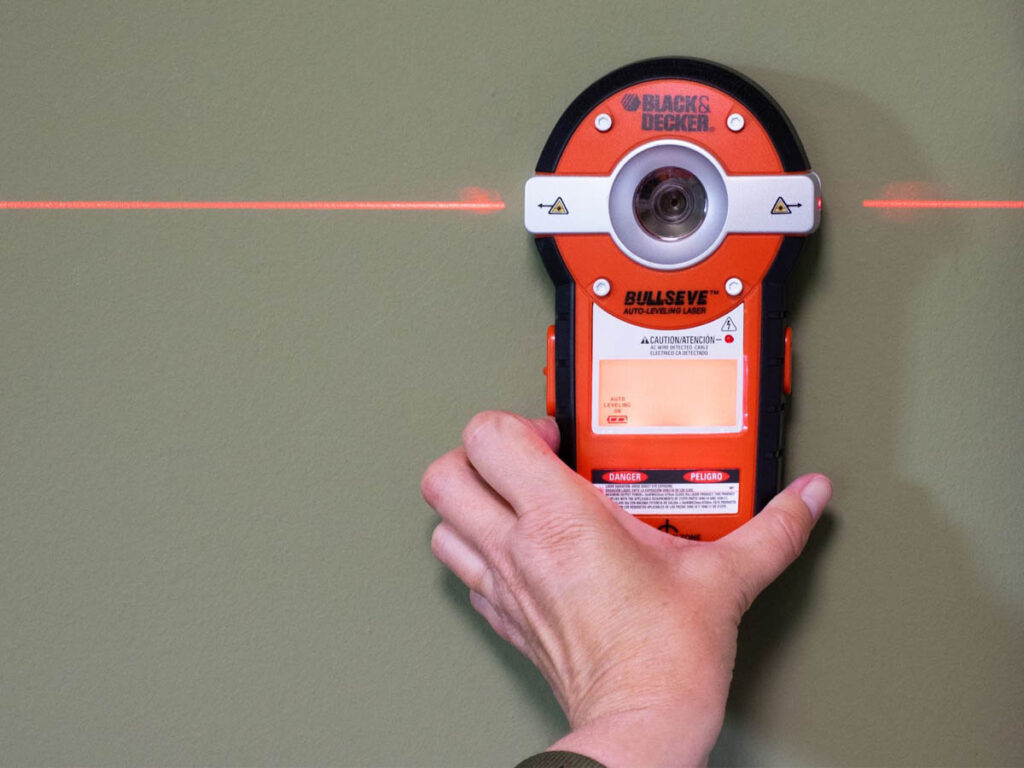A excellent stud finder can mean the difference between a successful and a disastrous DIY house project. When hammering or screwing anything into walls, ceilings, or floors, you must be aware of what is on the other side of the drywall. After all, you don’t want your large television to fall down because it wasn’t properly secured to a wall stud, or to strike a live wire while drilling a hole to hang bookcases. That is why a stud finder is so important.
All stud finders work on the same basic principle, whether they use electrical sensors or magnets: They detect the location of support sections within the walls, such as studs and joists. All stud finders can detect wood, the majority of them can detect metal, and many of them can detect active electrical wiring. Some finders offer minimal detection capabilities that are limited to walls. Others can be utilized on the walls, floors, and ceilings.
The best stud finder allow you to vary the depth to which the sensors penetrate the wall, increasing your chances of detecting anything important concealed below the drywall. Here are the best stud finder to meet all of your possible needs.
Do stud finders work through ceramic tile?
If you want to install grab bars in a bathroom with tiled walls, you can think about using a stud sensor to find the studs. While stud sensors can easily scan through drywall and similar materials, few can consistently scan through ceramic tile. That requires a scanner that employs radar to “look” through the wall, which is often very expensive. If you must anchor something heavy to a tiled wall, some deep-sensor stud sensors with metal detection settings can penetrate tile with reasonable precision.
Top 7 Best Stud Finder in 2024
In this article u can find out the Top 7 Best Stud Finder in 2024 list are below;-
1. BLACK+DECKER BullsEye Line Laser With Stud Sensor BDL190S
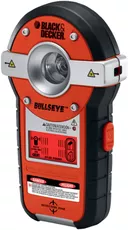
You get two tools in one with the BLACK+DECKER BullsEye Line Laser with Stud Sensor. It’s the excellent tool for hanging or mounting big items that need to be securely connected to a stud for support as well as exactly straight, such as cabinets, mirrors, hefty artwork, televisions, or shelves.
First, use the device to detect concealed things inside your wall, such as studs, metal pipes, timber support beams, and live AC cables. The gadget is suitable for use on drywall, lathe, plaster, and concrete walls. Simply push the power button—you’ll need to keep it depressed with your thumb or finger while working—slide the tool over the wall in your desired work area, and you’ll hear a beep when the tool comes into contact with a stud or other object inside the wall.
Switch the BullsEye to the level function once you’ve discovered the stud you wish to utilise to securely tie your object. If desired, a tiny pin on the rear of the gadget can be used to secure it to the wall while you work. The BullsEye’s line feature emits a red laser line up to 20 feet horizontally in both directions, providing lots of aid in precisely aligning whatever you want to hang. The BullsEye is shipped with two AA batteries and a two-year limited guarantee.
2. Franklin Sensors ProSensor 710 Precision Stud Finder
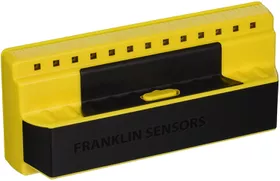
Above all else, a stud finder must be precise. If you can’t trust the tool you’re employing to avoid total disaster, there’s no purpose in investing in it. To complete a job successfully, you must first understand what is on the other side of the wall. The electronic ProSensor 710 Franklin Sensors Precision takes the top spot due to the accurate and detailed look it will provide while in use; its 13 sensors simultaneously “look” behind the walls or beneath the floors, pinpointing the location of wooden studs and metal objects easily and accurately.
The Precision can scan a large area of a wall for studs underneath. Because of the device’s increased width, you will have a more precise feel of stud positions as you move the finder across the surface. The front LED lights will illuminate, designating the location and width of any stud so you know exactly where the stud begins and finishes as you work.
3. Zircon MetalliScanner M40
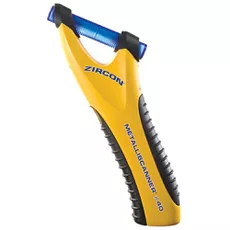
Metal is another type of support material that is frequently overlooked by stud finder calibrated for wood studs. Because many metals are not magnetic, magnetic finders may not detect all forms of metal. The Zircon MetalliScanner m40, on the other hand, is specifically intended to identify a wide range of metal supports and items concealed behind floors, walls, and ceilings.
The MetalliScanner can identify ferrous (magnetic) and non-ferrous metals hidden under most nonmetal walls, floors, and ceilings. Aside from metal studs and other support systems, this makes the finder ideal for identifying tiny items such as screws and nails embedded up to four inches deep in the wall. The blue coil illuminates as you move the finder, revealing the specific location of every object it detects, making it simple to locate hidden objects.
4. Bosch Digital Multi-Scanner GMS120
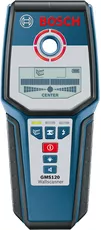
If you have a project that requires drilling or hammering into the floors or ceilings, such as hanging a ceiling fan, it’s critical to have an accurate sense of the support underlying these surfaces. You don’t want a giant piece of drywall crashing down on the floor or the top of your head. The Bosch GMS120 is a multi-scanning option that is easy to handle in odd situations, making overhead work safer and more convenient.
The finder’s ergonomic form incorporates a multi-mode sensor capable of detecting wood studs, metal support objects, and active AC wiring all at once. This finder is the best choice for flooring because it has a deep scan depth of 4.75 inches and can handle materials as dense as cured concrete. The LCD display and auditory detection signals provide additional feedback for locating and noting things beneath the floor surface.
5. Zircon StudSensor e50 Electronic Wall Scanner

There’s no need to spend a fortune on a stud sensor for a weekend home improvement project. However, you must exercise caution because many lower-priced alternatives lack the accuracy required to drill into your walls without hitting something you didn’t anticipate to be there. Typically, the best inexpensive options provide the essentials without the additional detecting skills. The Zircon StudSensor e50 provides basic wood and metal stud identification at a low cost without sacrificing precision.
This finder has a lot of useful functions for such a low price. The finder, which can detect both wood and metal studs, will flash and beep once it has picked up the edge of a stud. There are two scanning modes available: StudScan for studs up to 0.75 inches deep and DeepScan for targets up to 1.5 inches deep. The finder can also detect live AC wires, allowing you to avoid drilling into potentially harmful electrical risks.
6. Folai Wall Scanner
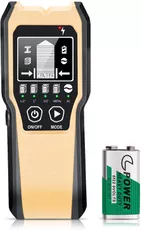
Live electrical wiring is one of the most dangerous objects buried inside walls and ceilings. Wiring to lights, outlets, and switches can be lethal if you are drilling or hammering into your walls while the power is turned on. Even if the power is turned off, you can avoid the hassle of severing a wire by using a finder that detects the smaller profile of AC lines, such as the Folai Wall Scanner. If you want to be extra cautious when working with electrical wiring, this stud finder can give you extra piece of mind.
But finding AC wires isn’t the only thing this wall scanner can do; the finder has five distinct scanning modes for woods, metals, and AC cables concealed up to 2 inches behind walls. It’s simple to use the scanner: The huge LCD display reveals the depth and direction of studs or other items concealed inside walls, and audio beeps indicate whether you are going closer or further away from the hidden object.
7. CH Hanson 03040 Magnetic Stud Finder
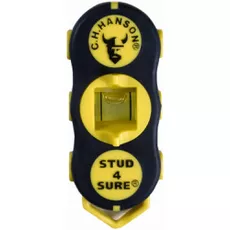
Magnetic stud finder are the more traditional cousins of current, more sophisticated electronic finders. Despite its simplicity, a decent magnetic finder might be an excellent budget or backup solution if you want something that doesn’t require batteries. Stud finder, such as the CH Hanson 03040, use a built-in magnet to naturally attract the nails and screws that keep the home’s frame together, giving you a good indication of where studs are behind the wall.
The finder is powered by powerful rare earth magnets and does not require batteries to locate metal studs and fasteners. The body of the finder also features a two-way level, allowing you to hang the finder from a metal stud to correctly level walls and other surfaces. A pointed arrow on the bottom marks the safe position for screws and nails, minimising the need for trial-and-error while hanging pictures, frames, and other things on the walls.

